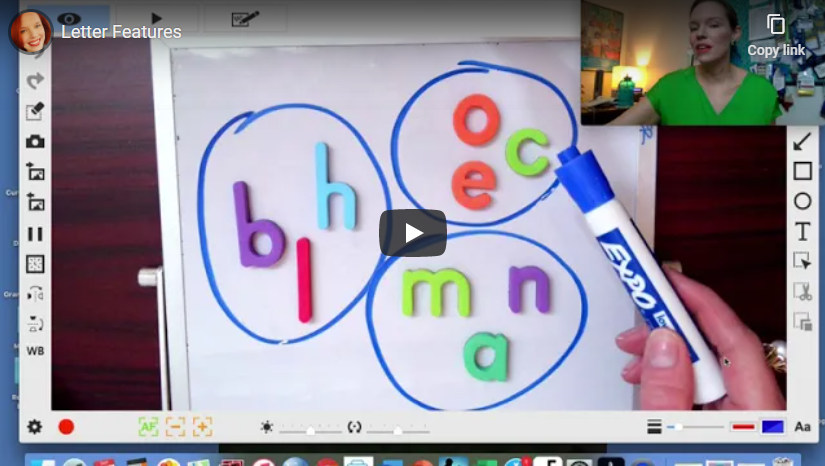One of my former Reading Recovery students, Sandra (a pseudonym), had difficulties writing her name. Every time she wrote it, the letter “a” had a long tail that made it look like the letter “q.” When I administered letter identification, dictation, and writing vocabulary assessment tasks, many other issues with letter reading and writing emerged. I knew that if she were going to read continuous text successfully I would have to be intentional and careful in my planning for each lesson in the area of letter identification. My approaches to subsequent instruction included using magnetic letters as a model when we wrote together, sorting magnetic letters by their features, and using verbal pathways when writing letters on different surfaces (e.g., on a chalkboard and in sand.).
The National Reading Panel (2000), after conducting a meta-analysis of studies, determined that alphabet knowledge is the single best predictor of reading and writing success. In studies of eye movements during reading, “skillful readers visually process virtually each letter of every word they read” (Adams, 2013, p. 789), and they do this while also reading for meaning. So, it is important to teach children to quickly and automatically identify letters, not only in isolation, but how to “survey words in a controlled way, left to right” in embedded text (Clay, 1991, p. 270). Children need to be able to discriminate letters by noticing their features so that they can “distinguish a new word from all other known words” (Clay, 1991, p. 272).
Letter Assessment
Assessing how children are working with letters related to identification, linking to sounds, and in reading and writing can be accomplished by several means. Letter identification can be assessed by showing children isolated letters (both upper- and lowercase) and inviting them to name the letters or provide a sound for the letter or a word that begins with that letter. Noting how rapidly the child accomplishes this task is also important, as are analyzing hesitations, confusions, and self-corrections. Teachers might assess how a child categorizes and discriminates letters by their features (e.g., putting all the letters with a circle into a group) as well as what the child is able to do with letters (and their sounds) in words when asking them to read an isolated word or a word in text. Observing children’s eye movements while reading can be helpful, too, noticing where they look first – beginning, middle, or end of a word. Writing is also a strong indicator of children’s knowledge of letters – how they form letters (top to bottom, bottom to top), how smooth (or not) the writing of each letter is, how many strokes they use to form a letter, how they hold the writing utensil, and how fluently they form a letter.
A letter identification assessment task can be administered virtually in a similar manner as administering it in person. The teacher simply shares the screen with the letters or places it under a document camera, always making sure that the letters are large enough for the child to see them clearly. The child responds to the prompt to identify the letters, and the teacher records their responses. The child can also write a dictated sentence for the teacher to then analyze for letter formation. The only tricky part is how to observe children’s eye movements virtually! It is next to impossible to tell where they are looking while reading to assess their knowledge of beginning/middle/end of a word when they are on the other side of the screen.
Letter Instruction
In order to identify letters, children need to be able to quickly discriminate between them, noticing their differences. A useful instructional strategy is to have children sort letters into groups, such as finding all the letters with a circle or all the letters with a tall stick. This then helps them to see that, even though the letters they grouped possess similar properties, they are different from one another in some way. It’s even fine to include letters in sorting procedures that the children aren’t able to identify yet. The kinesthetic aspect of sorting is quite helpful in getting children active while working with letters.
Clay (2005) discussed three ways of remembering: having a visual model, providing verbal instructions, and allowing opportunities for movement. When working with letters using all three of these modes, the instruction will be powerful. For example, the teacher invites the child to form the letter “b” while showing the child a model of the letter “b,” giving verbal instructions to form the letter (i.e., “Move down, up, and around), and having the child write the letter in the air.
There are several important research findings related to letter instruction that should be considered when planning lessons (Justice et al., 2006). 1) Children learn letters that are in their own names first; 2) the first and last letters of the alphabet are usually easier to learn; 3) letters that appear more frequently in text are easier to learn; and 4) it’s easier to learn letters together that possess different features.
To address #1, teachers can have students make their names with magnetic letters and create name puzzles with sentence strips, where the child cuts their name apart by the letters and puts them back together to form their name.
To address #2, the alphabet arc can be used, drawing attention to the order of the letters as children are asked to place the letters on the mat in order. There are also virtual alphabet arcs available for remote learning. Here’s a video I created on using the alphabet arc:
To address #3, try teaching letters during small group guided reading lessons and start with the ones that appear at the beginning of a sight word or two that you are working with.
To address #4, letter sorting is an effective activity. The teacher can invite children to sort letters in many ways by their features. Here’s a video I created on letter sorting:
Associating the letters with their sounds is extremely important during letter identification and formation activities (Reutzel, 2015). This helps cement the letter in the child’s long-term memory because the child is making connections. The child can then use this information when reading continuous text (Invernizzi & Buckrop, 2018). An alphabet linking chart is a wonderful tool for this. Even virtually, the child and teacher can work with the chart in many ways: reading the letters, reading the words, reading the consonants or vowels, and locating the matching letter or sound.
Creating opportunities for children to have successful experiences working with letters in fast and fluent ways is imperative to their future as readers. So break out those magnetic letters and have some fun!
Happy Reading!
Bethanie
References
Adams, M. J. (2013). Modeling the connections between word recognition and reading. In D. E. Alverman, N. J. Unrau, & R. B. Ruddell (Eds.), Theoretical models and processes of reading, 6th ed., pp. 783-806. International Reading Association.
Clay, M. M. (1991). Becoming literate: The construction of inner control. Heinemann.
Clay, M. M. (2005). Literacy lessons designed for individuals: Part two. Heinemann.
Invernizzi, M., & Buckrop, J. (2018). Reconceptualizing alphabet learning and instruction. In C. M. Cassano & S. M. Dougherty (Eds.), Pivotal research in early literacy: Foundational studies and current practices pp. 85-110. Guilford.
Justice, L. M., Pence, K., Bowles, R. B., & Wiggins, A. (2006). An investigation of four hypotheses concerning the order by which 4-year-old children learn the alphabet letters. Early Childhood Research Quarterly, 21(3), 374-389.
Reutzel, D. R. (2015). Early literacy research: Findings primary-grade teachers will want to know. The Reading Teacher, 69(1), 14-24.
Like what we've got to say? Spread the word!

